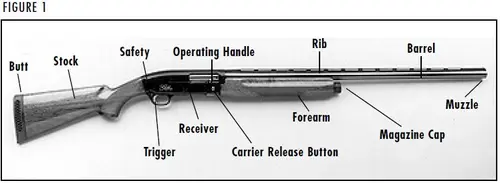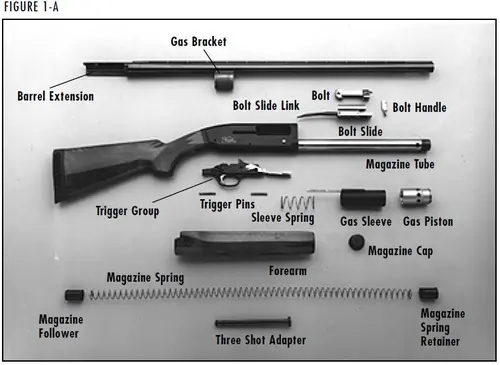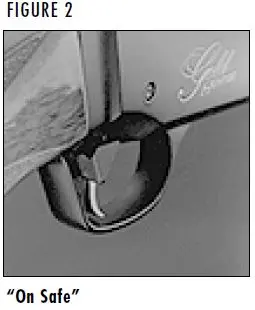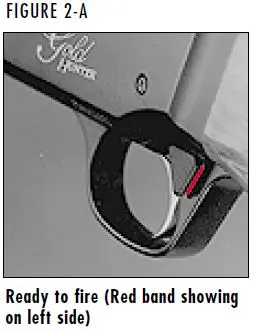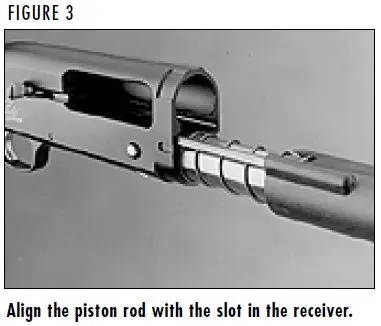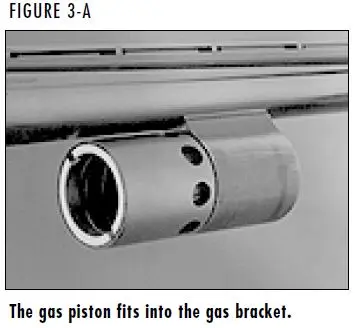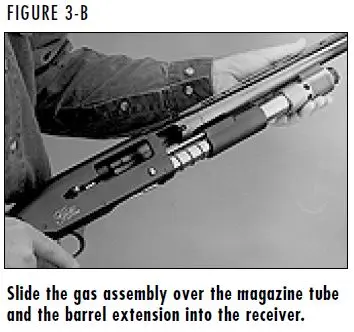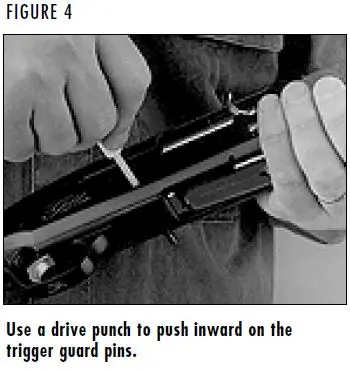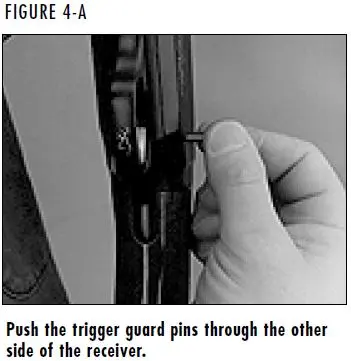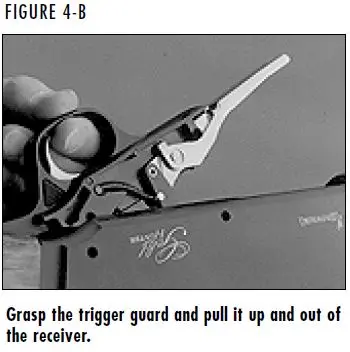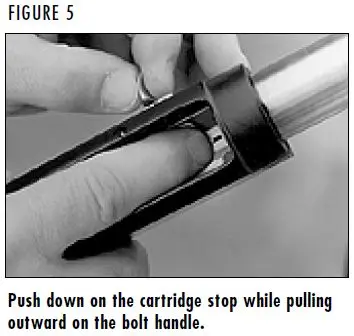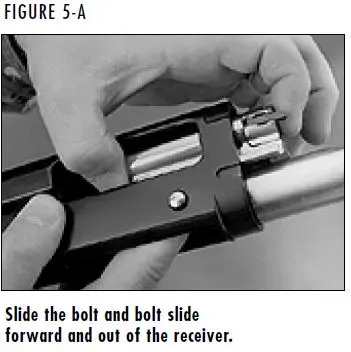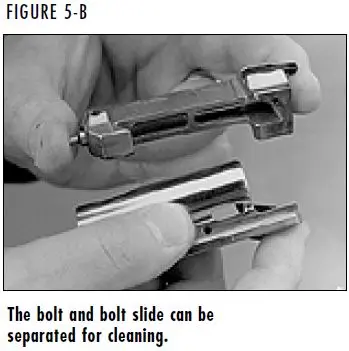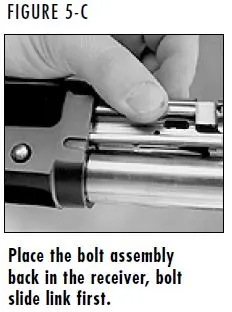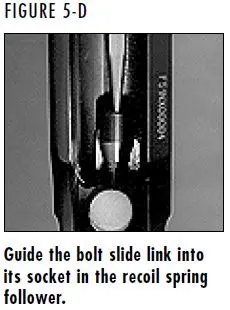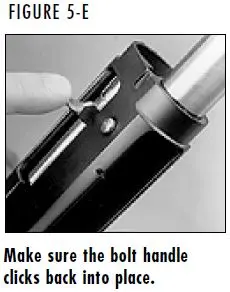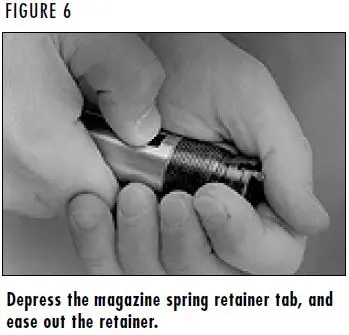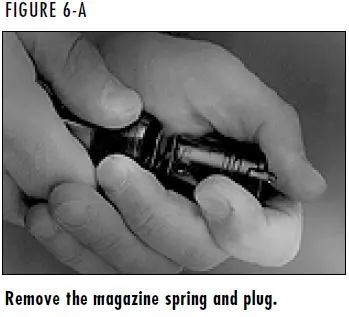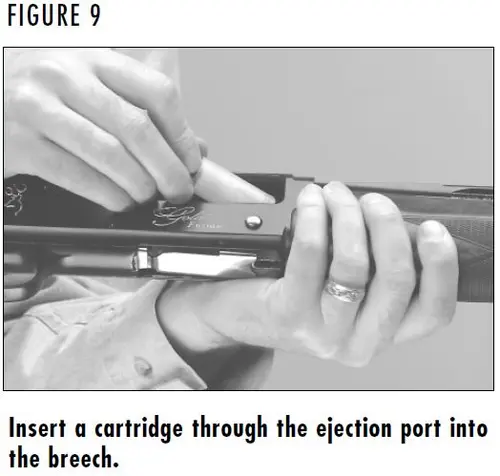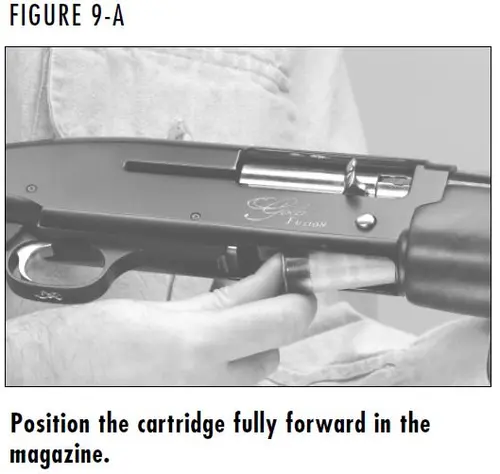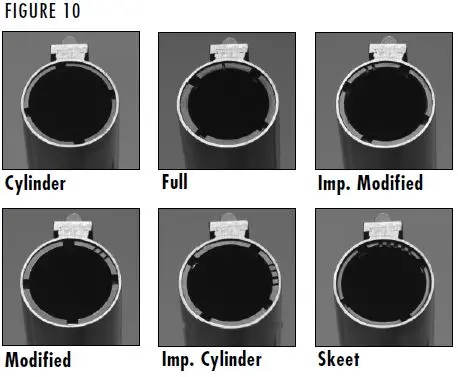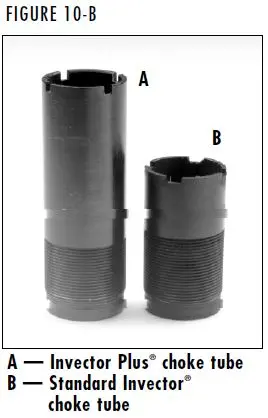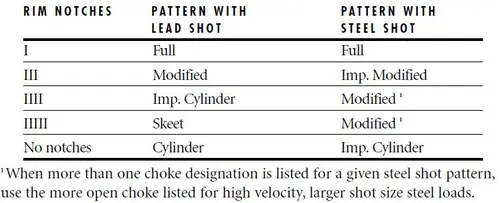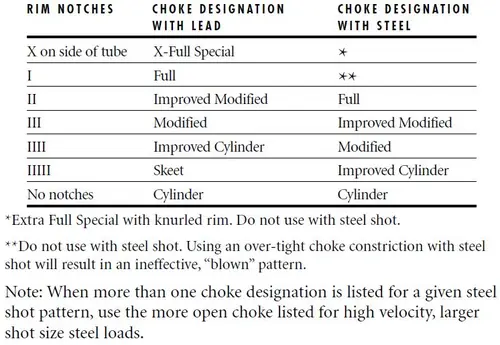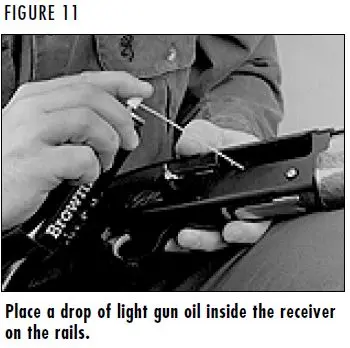Operation and care of
Gold 12 & 20 Gauge Shotgun
Gold 12 & 20 Gauge Shotgun
THANK YOU FOR CHOOSING A BROWNING GOLD AUTOLOADING SHOTGUN.
THANK YOU FOR CHOOSING A BROWNING GOLD AUTOLOADING SHOTGUN.
The Gold shotgun represents a new generation of Browning gas-operated, autoloading shotguns. The Gold 12 and 20 gauge incorporate the best of traditional Browning craftsmanship and advanced technology. Every detail of the Gold shotgun has been engineered to provide you the best in handling and reliable operation. With a reasonable amount of care your Gold shotgun should give you many years of dependable, enjoyable service. Please feel free to write us immediately if you have any observations regarding its performance and operation.
You Are Responsible for Firearms Safety
As a gun owner, you accept a set of demanding responsibilities. How seriously you take these responsibilities can be the difference between life and death. Failure to follow any of these instructions can cause extensive damage to your gun and / or possible serious injury or death to yourself and others.
There is no excuse for careless or abusive handling of any firearm. At all times handle your shotgun and any other firearm with intense respect for its force, power and potential danger.
PLEASE READ AND UNDERSTAND ALL OF THE CAUTIONS, THE PROPER HANDLING PROCEDURES AND INSTRUCTION OUTLINED ON THIS PAGE BEFORE USING YOUR NEW FIREARM.
PLEASE READ AND PRACTICE THE FOLLOWING CAUTIONS:
CAUTION
1 - ALWAYS KEEP THE MUZZLE OF YOUR FIREARM POINTED IN A SAFE DIRECTION even though you are certain the shotgun is unloaded and '' on safe.'' Never point any firearm at anything you do not intend to shoot. Be extremely alert and aware of all persons and property within range of your ammunition.
2 - NEVER RELY TOTALLY ON YOUR SHOTGUN'S MECHANICAL "SAFETY" DEVICE.
Always assume that your gun can be fired at any time, even with all safety mechanisms engaged. The word "safety" describes a gun's mechanical devices that are designed to place your gun in a SAFER status. No guarantee can be made that the gun will not fire even if the "safety" is in the "on safe" position. See "Operation of the Safety" later in this manual for instructions on operation of this gun's "safety."
LIKE ANY MECHANICAL DEVICE, A "SAFETY" CAN SOMETIMES FAIL; IT CAN BE JARRED OR INADVERTENTLY MANIPULATED INTO AN UNSAFE CONDITION.
Mechanical "safeties" merely aid safe gun handling and are no excuse for pointing your shotgun's muzzle in an unsafe direction. While it is a good idea to "test" your gun's mechanical "safeties" periodically for proper function, NEVER TEST THEM WHILE YOUR FIREARM IS LOADED OR POINTED IN AN UNSAFE DIRECTION.
Safe gun handling does not stop with your gun's mechanical "safety" devices - it starts there. Alvays treat this shotgun with the respect due a loaded, ready-to-fire firearm.
NEVER TEST THE MECHANISM OF ANY FIREARM WHILE IT IS LOADED OR POINTED IN AN UNSAFE DIRECTION.
3 - WHENEVER YOU HANDLE A FIREARM, OR HAND IT TO SOMEONE, MAKE SURE IT IS COMPLETELY UNLOADED. Always open the action immediately, and visually check the chamber. Make certain that they do not inadvertently contain any ammunition. Always keep the chamber empty and "safety" in the "on safe" position unless shooting is imminent.
4 - DO NOT TRANSPORT ANY LOADED FIREARM.
Keep all firearms unloaded during transport, whether stored in a holster, gun case, scabbard or other container.
5 - HUNTING FROM ELEVATED SURFACES SUCH AS TREE STANDS IS DANGEROUS.
Doing so may increase the risk of handling a firearm. The following rules should always be observed by you and those you hunt with: Always make certain that the stand being used is safe and stable. Always make certain that your firearm is unloaded when it is being taken up and down from the stand. Always make certain that your firearm is not dropped from the stand, or dropped while it is being taken up or down from the stand. Remember, a loaded firearm may discharge when dropped, even with the safety in the "on safe" position.
6 - BEWARE OF BARREL OBSTRUCTIONS, FOR THE SAFETY OF BOTH YOUR GUN AND YOURSELF. Mud, snow, and an infinite variety of other objects may inadvertently lodge in a barrel bore. It takes only one small obstruction to cause dangerously increased pressures that can ruin (swell or rupture) the finest shotgun barrels.
BEFORE CHECKING FOR A BARREL OBSTRUCTION, BE CERTAIN YOUR FIREARM IS FULLY UNLOADED.
Make sure no love rounds are in the chamber(s). Place the safety in the "on safe" position.
After assuring yourself that the firearm is completely unloaded, again, open the action, and look through the barrels to be sure they are clear of any obstruction. If an obstruction is seen, no matter how small it may be, clean the bore with a cleaning rod and patch as described later in this manual. Before the first firing, clean both bores with a cleaning rod and patch, and wipe away any anti-rust compounds in the action / chamber areas.
7 - ALWAYS COMPLETELY UNLOAD YOUR SHOTGUN WHEN NOT IN USE.
As a safety precaution, it is preferable to disassemble your gun for storage. Your responsibilities do not end when your firearm is unattended. Store your firearm and ammunition separately and well beyond the reach of children. Take all safeguards to ensure your shotgun does not become available to untrained, inexperienced or unwelcome hands.
8 - USE THE PROPER AMMUNITION. The barrel and action of all Browning fireams have been made with substantial safety margins over the pressures developed by established American commercial loads. Nevertheless, Browning assumes no liability for incidents which occur through the use of cartridges of nonstandard dimensions which develop pressures in excess of commercially available ammunition which has been loaded in accordance with standards established by the Sporting Arms and Ammunition Manufacturers' Institute (SAAMI)
9. BE ALERT TO THE SIGNS OF AMMUNITION MALFUNCTION. If you detect an off sound or light recoil when a shell is fired, DO NOT LOAD ANOTHER SHELL INTO THE CHAMBER. Open the action and remove the shell from the chamber. With the action open, glance down the barrel to make sure that an obstruction does not remain in the barrel. If there is an obstruction, completely clear the barrel before loading and firing again. Failure to follow these instructions can cause extensive damage to your gun and possible serious injury to yourself and others.
10. MAKE SURE OF ADEQUATE VENTILATION IN THE AREA THAT YOU DISCHARGE A FIREARM. WASH HANDS THOROUGHLY AFTER EXPOSURE TO AMMUNITION OR CLEANING A FIREARM.
Lead exposure can be obtained from discharging firearms in poorly ventilated areas, cleaning firearms or handling ammunition. Lead is a substance that has been known to cause birth defects, reproductive harm and other serious injury.
11 - NEVER INSERT A SHELL OF THE INCORRECT GAUGE IN ANY SHOTGUN.
The gauge of your shotgun is marked on the side of the barrel. Store all shells of different gauges in completely separate and well-marked containers. Never store shells of mixed gauges in a common container or in your pockets.
EXAMINE EVERY SHELL YOU PUT IN YOUR GUN. NEVER PUT A 20 GAUGE SHELL IN A 12 GAUGE GUN.
The most certain way to bulge or rupture a shotgun barrel is to drop a 20 gauge shell into a 12 gauge chamber. The 20 gauge shell, unfortunately, will not fall completely through the barrel; its rim is caught by the front of a 12 gauge chamber. Your gun will misfire (with the chamber appearing to be empty). It is then possible to load a 12 gauge shell behind the 20 gauge shell. If the 12 gauge shell is then fired, the result will be a so-called "12-20 burst" which can cause extensive damage to your gun and possible serious inju1y to you and others.
12 - USE SHELLS OF THE CORRECT LENGTH.
Do not use 3 1/2" shotgun shells in a shotgun or barrel with a 2 3/ 4" chamber or 3" chamber. Do not use 3" shells in a shotgun chambered for 2 3/4" shells. Doing so can result in a buildup of dangerously high pressures that may damage your gun and possibly cause serious injury to yourself or others.
The size of the chamber is inscribed, along with gauge and choke designations, on the side of the barrel. The Gold semi-auto is chambered for 3" 12 or 3" 20 gauge loads.
13 - DO NOT SNAP THE FIRING PIN ON AN EMPTY CHAMBER - THE CHAMBER MAY NOT BE EMPTY! Treat every gun, with the respect due a loaded gun, even though you are certain the gun is unloaded.
14 - KEEP YOUR FINGERS AWAY FROM THE TRIGGER WHILE UNLOADING AND LOADING, UNTIL YOU ARE READY TO SHOOT.
15 - BE SURE OF YOUR TARGET AND BACKSTOP - Particularly during low light periods. Know the range of your ammunition. Never shoot at water or hard objects.
16 - ALWAYS UNLOAD THE CHAMBER AND MAGAZINE BEFORE CROSSING A FENCE, CLIMBING A TREE, JUMPING A DITCH OR NEGOTIATING OTHER OBSTACLES. Never place your loaded rifle on or against a fence, tree, car, or other similar object.
17 - WEAR EYE AND EAR PROTECTION WHEN SHOOTING. Unprotected, repeated exposure to gunfire can cause hearing damage. Wear ear protectors (shooting ear plugs or muffs) to guard against such damage. Wear shooting glasses to protect your eyes from flying particles. Allow proper distance (eye relief) between the scope and your eye when firing a scoped rifle or shotgun. Always keep a safe distance between the muzzle of your firearm and any persons nearby, as muzzle blast, debris and ejecting shells could inflict serious injury. Also, wear eye protection when disassembling and cleaning your shotgun to prevent the possibility of springs, spring-tensioned parts, solvents or other agents from contacting your eyes.
18 - DROPPING OR JARRING A LOADED GUN CAN CAUSE AN ACCIDENTAL DISCHARGE.
This can occur even with a firearms "safety" in the "on safe" position. Be extremely careful while hunting or during any shooting activity, to avoid dropping any firearms.
19 - IF YOUR SHOTGUN FAILS TO FIRE, KEEP THE MUZZLE POINTED IN A SAFE DIRECTION.
Hold this position for a minimum of 30 seconds. Carefully open the action and remove the cartridge. If the primer is indented, the cartridge should be disposed of in a way that cannot cause harm. If the primer is not indented, your firearm should be examined by a qualified gunsmith and the cause of the malfunction should be corrected before further use.
20 - BE DEFENSIVE AND ON GUARD AGAINST UNSAFE GUN HANDLING AROUND YOU AND OTHERS.
Don't be timid when it comes to gun safety. If you observe other shooters violating any of these safety precautions, politely suggest safer handling practices.
21 - BE CERTAIN YOUR SHOTGUN IS UNLOADED BEFORE CLEANING
Because so many gun accidents occur, when a firearm is being cleaned, special and extreme care should be taken to be sure your gun is unloaded before disassembly, cleaning and reassembly. Keep ammunition away from the cleaning location. Never test the mechanical function of any firearm with live ammunition.
22 - TEACH AND SUPERVISE FIREARMS SAFETY TO ALL MEMBERS OF YOUR FAMILY-ESPECIALLY TO CHILDREN AND NONSHOOTERS.
Closely supervise newcomers to the shooting sports. Encourage enrollment in hunting / shooting safety courses.
23 - NEVER DRINK ALCOHOLIC BEVERAGES OR TAKE ANY TYPE OF DRUGS BEFORE OR DURING SHOOTING.
Your vision and judgment could be dangerously impaired, making your gun handling unsafe to you and to others.
24 - PERFORM PERIODIC MAINTENANCE - AVOID UNAUTHORIZED SERVICING!
Your new firearm is a mechanical device which will not last forever, and as such, is subject to wear and requires periodic inspection, adjustment, and service. Browning firearms should be serviced by a Browning Recommended Service Center or by Browning's service facility in Arnold, Missouri. Browning cannot assume any responsibility for injuries suffered or caused by unauthorized servicing, alterations or modifications of Browning firearms.
25 - BROWNING RESERVES THE RIGHT TO REFUSE SERVICE ON FIREARMS THAT HAVE BEEN ALTERED, ADDED TO OR SUBSTANTIALLY CHANGED.
Removal of metal from barrel(s), or modifications of the firing mechanism and / or operating parts may lead to Browning's refusal of service on such firearms. Browning will charge the owner for parts and labor to return the firearm to original Browning specifications.
26 - READ AND HEED ALL WARNINGS in this instruction book, on ammunition boxes and with all accessories that you install on your firearm. It is your responsibility to secure the most up-to-date information on the safe handling procedures for your Browning gun. Browning assumes no liability for incidents which occur when unsafe or improper gun accessories or ammunition combinations are used.
Browning assumes no liability for incidents which occur when unsafe or improper gun accessories or ammunition combinations are used.
DO NOT, UNDER ANY CIRCUMSTANCES, ALTER THE TRIGGER OR OTHER PARTS OF THE FIRING MECHANISM OF THIS OR ANY OTHER FIREARM. FAILURE TO OBEY THIS WARNING MAY RESULT IN INJURY OR DEATH TO YOURSELF OR OTHERS.
BE CAREFUL!
BE CAREFUL!
Gold 12 & 20 Gauge Shotgun
Gold 12 & 20 Gauge Shotgun
Nomenclature
Nomenclature
In conventional gun terminology, the position and movement of shotgun parts are described as they occur with the shotgun horizontal and in normal firing position; i.e. the muzzle is forward or front; the butt stock is rearward or rear; the trigger is downward or underneath; the sight is upward or on top. For general parts nomenclature, refer to Figure 1. The Browning Gold shotgun is shown disassembled to the extent necessary in order to follow the instructions contained in this book (Figure 1-A below).
General Operation
General Operation
The Browning Gold shotgun is a gas operated, autoloading shotgun. It is capable of shooting five shots (with the magazine plug removed using 2 3⁄4" loads) in rapid succession with each pull of the trigger. Upon firing, high pressure gas from behind the shot charge passes through two ports in the barrel, through the gas bracket and into the gas cylinder. High pressure gases force the gas piston rearward, applying pressure to the piston rod. As the piston rod moves rearward, it pushes the bolt assembly rearward, operating the action. As the bolt assembly moves rearward, it recocks the hammer and ejects the fired shell. After full rearward travel, the bolt assembly returns forward, picking up a new shell from the magazine and chambering it automatically.After the last shell has been fired, the bolt assembly locks to the rear, instead of returning forward. This facilitates speedy reloading. The short-stroke of the gas piston along with the snug, gas sealing fit of the piston rod limits the amount of combustion gases blown out of the gas cylinder and into the receiver, keeping the inside of the receiver clean.
NOTE: The Gold shotgun is delivered with the magazine adapter in the magazine which limits the gun to three shots, in accordance with federal migratory bird laws. If you do not want your gun to be limited, merely take out the three shot adapter as explained in the section below titled "Three Shot Adapter."
Initial Cleaning
Initial Cleaning
Various exposed metal parts of your new gun have been coated at the factory with a rust preventative compound. Before assembling your shotgun, clean the anti-rust compound from the inside of the barrel, receiver and the action-chamber areas. Browning Oil is ideal for removing this compound and for giving your new gun its first lubrication. However, any quality gun oil may be used. Clean the barrel using a cleaning rod and patch as explained under “Cleaning and Maintenance Suggestions” section below.
Serial Number
Serial Number
The serial number of your Gold shotgun is found on the left side of the receiver-just below the engraving "Gold Hunter."
Ammunition
Ammunition
The Gold Autoloading 12 and 20 gauge shotguns shoot all factory lead and steel 12 or 20 gauge 2 3⁄4" and 3" loads. Browning can assume no responsibility for incidents which occur through the use of cartridges of nonstandard dimension or those developing pressures in excess of SAAMI (Sporting Arms and Ammunition Manufacturer’s Institute) established standards.
Initial Cleaning
Initial Cleaning
Various exposed metal parts of your new Recoilless have been coated at the factory with a rust preventative compound. Clean the anti-rust compound from the inside of the barrel and chamber, and generally wipe clean the metal surfaces at the rear of the forearm, on the interior areas of the receiver, as well as any other parts coated with this compound. Browning Oil is ideal for wiping and cleaning these parts and for giving your gun its first lubrication.
Clean the barrel using a cleaning rod and patch as explained under "Cleaning Suggestions." Read this entire manual before performing the first cleaning, to learn necessary information on opening the action, etc.
Operation of the Safety
Operation of the Safety
The cross bolt safety prevents the trigger from being pulled when in the "on safe" position. The safety is located at the rear of the trigger guard (Figure 2). In the “off safe” position, a red warning band is visible on the safety button on the left side of the trigger guard.
To place the gun “ON SAFE,” press the safety button to the right. To move the safety to the FIRE position, press the safety to the left (Figure 2-A).
The safety is reversible and can be reversed from right- to left-handed by a competent gunsmith. When installed, the left-handed safety will have the safety button’s red warning band on the RIGHT side of the trigger guard.
NOTE: DO NOT DEPEND ON THE RED COLOR ALONE TO INDICATE YOUR GUN’S SAFETY STATUS, AS TIME, EXPOSURE TO THE ELEMENTS, AND THE ABRASIVE ACTION OF CLEANING AGENTS CAN ERASE IT.
How to Assemble The Barrel to the Receiver
How to Assemble The Barrel to the Receiver
The Gold shotgun is delivered, in the box, with the barrel removed and the forearm still attached to the magazine tube. It is important to follow the exact sequence for assembly in steps 1 and 2, in order to properly assemble your Gold shotgun.
ALWAYS PLACE THE SAFETY IN THE "ON SAFE" POSITION BEFORE ASSEMBLY PROCEDURES AND CHECK YOUR GUN CAREFULLY TO BE CERTAIN THAT THE CHAMBER, FEED MECHANISM AND MAGAZINE CONTAIN NO SHELLS.
1 - Take the receiver in hand. First, lock the bolt rearward by pulling the operating handle fully to the rear. Remove the forearm from the magazine tube by unscrewing the magazine cap and sliding the forearm forward, off the magazine tube.
DO NOT SQUEEZE HARD ON THE OPEN REAR END OF THE FOREARM. TOO MUCH PRESSURE COULD CAUSE THE WOOD TO SPLIT.
2 - Components of the gas system - the sleeve, sleeve spring and gas piston will remain in place and do not need to be removed, except for cleaning. If the components of the gas system have been removed, reinstall them as explained below. Otherwise, proceed to step 5.
3 - Slide the sleeve onto the magazine tube with the piston rod end first. Check the piston rod to make sure it is aligned with the slot on the right side (ejection port side) of the receiver Make sure the sleeve spring is properly positioned in the sleeve. (See Figure 3).
4 - Slide the gas piston into the gas bracket. (See Figure 3A).
5 - With the gun in the vertical position, line the gas bracket and gas piston over the magazine tube (See Figure 3B). Slide the gas bracket and gas piston over the magazine tube. The barrel extension should slip solidly down into the receiver. Make sure the piston rod moves freely in its slot in the receiver.
6 - Replace the forearm by sliding it onto the magazine tube and over the gas bracket so it seats securely. Install the magazine cap. Make sure the magazine cap is fully tightened down. Open and close the action several times and retighten the magazine cap. This will ensure a proper seal.
Disassembly of the Barrel From the Receiver
Disassembly of the Barrel From the Receiver
BEFORE STARTING DISASSEMBLY PROCEDURES, VISUALLY INSPECT THE CHAMBER, FEED MECHANISM AND MAGAZINE TO BE ABSOLUTELY CERTAIN THE SHOTGUN IS COMPLETELY UNLOADED. POINT THE BARREL IN A SAFE DIRECTION.
1 - Unscrew the magazine cap and remove it.
2 - Remove the forearm by sliding it forward off the magazine tube.
3 - For cleaning, remove the barrel, piston and piston sleeve by sliding thern forward off the magazine tube. See "Cleaning and Maintenance Suggestions" in the section below.
If you are disassembling for storage, return the piston and piston sleeve onto the magazine tube as shown previously in Figure 3B. Reinstall the forearm over the magazine tube and screw on the magazine cap. You will then have two compact units: the barrel, and the action with forearm and stock.
CAUTION: AFTER THE BARREL HAS BEEN REMOVED FROM YOUR GUN, LEAVE THE BOLT IN THE OPEN POSITION. DO NOT PRESS THE CARRIER RELEASE BUTTON.
If the bolt is released forward with the barrel removed, the cartridge stop will hit the front of the receiver and cause damage.
Disassembly of the Trigger Group and Bolt Assembly
Disassembly of the Trigger Group and Bolt Assembly
The trigger group or bolt can be removed if the action becomes excessively dirty or wet. If this occurs, disassemble the action for a complete cleaning as explained below. Your Gold shotgun is designed to allow full disassembly of the trigger group and bolt assembly in the field, without any tools. Detailed cleaning procedures are outlined under "Cleaning and Maintenance" section below. Full disassembly involves removal of the bolt assembly and the trigger group. Any disassembly beyond this should only be performed by a competent gunsmith.
ALWAYS WEAR EYE PROTECTION WHEN PERFORMING ANY MAINTENANCE OR DISASSEMBLY.
REMOVING THE TRIGGER GROUP -
1. First, make certain the gun is totally unloaded and the "safety" is "on safe." CHECK THE MAGAZINE, FEED MECHANISM AND CHAMBER TO BE SURE THEY DO NOT CONTAIN ANY SHELLS.
2. While holding the bolt handle, release the bolt to its forward position by depressing the carrier release button. Again use caution when releasing the bole assembly to its forward position. If you allow the bolt assembly to slam closed with the barrel removed you can damage the receiver.
3. With the gun inverted, (trigger guard up) use a drive punch or similar object to push inward on the trigger guard-pins, using caution not to scratch the receiver (See Figure 4). Trigger guard pins may be removed from either side of the receiver. Push the trigger guard pins clear through the other side of the receiver. It may be necessary to pull on the trigger pins to remove them from the receiver (See Figure 4A).
4. Grasp the trigger guard and pull it up and out of the receiver. (See Figure 4B).
5. Perform any cleaning of the parts and receiver cavity as necessary.
DO NOT DISASSEMBLE THE TRIGGER GROUP BEYOND THIS POINT.
REASSEMBLY -
1. Make sure the bolt is in the forward position.
2. Insert the trigger group back into the receiver. The holes in the trigger group should line up with the holes on each side of the receiver.
3. Reinsert the trigger guard pins and gently tap them into place with a plastic or wooden mallet, again using caution not to scratch the receiver.
REMOVING THE BOLT ASSEMBLY
REMOVING THE BOLT ASSEMBLY
To remove the bolt assembly it is preferred to first remove the trigger group, as explained previously.
1. With the gun inverted (trigger guard up position), push down on the cartridge stop while pulling outward on the bolt handle (See Figure 5). Remove the bolt handle from the bolt.
2. While keeping the cartridge stop depressed, slide the bolt and bolt slide forward and out of the receiver (See Figure 5A).
3. The bolt and bolt slide can be separated for cleaning (See Figure 5B). Perform any cleaning of the bolt and receiver cavity as necessary.
DO NOT DISASSEMBLE THE BOLT ASSEMBLY BEYOND THIS POINT.
Reinstalling the Bolt Assembly
Reinstalling the Bolt Assembly
1. Reassemble the bolt and bolt slide.
2. Place the bolt assembly back in the receiver, bolt slide link end first (See Figure 5C). Line the rails on the bolt slide with the slots in the bottom of the receiver.
3. Guide the bolt slide link into its socket in the recoil spring follower (See Figure 5D).
4. To replace the operating handle push down on the cartridge stop and insert the bolt handle in its respective slot in the bolt. IMPORTANT: It may be necessary to pull out on the bolt handle slightly until the cartridge stop clicks back in place (See Figure 5E). Failure to follow these instructions will result in the inability to load the magazine.
5. Open and close the action several times to make sure the bolt slide link and recoil spring follower are properly engaged.
Three Shot Adapter / Magazine Capacity
Three Shot Adapter / Magazine Capacity
The Gold shotgun is delivered wirh the magazine three shot adapter (plug) installed in the magazine, limiting, magazine capacity to two shells in compliance with federal rnigratory bird regulations. If you do not wish to be limited to three shots - when it is not required by law - you can remove (or reinstall) the three shot adapter (plug) as follows:
ALWAYS WEAR PROTECTIVE SAFETY GLASSES DURING THIS OPERATION.
1. First, make certain the gun is totally unloaded and the "safety" is "on safe." CHECK THE MAGAZINE, FEED MECHANISM AND CHAMBER TO BE SURE THEY DO NOT CONTAIN ANY SHELLS.
2. Unscrew the magazine cap and remove it.
3. The magazine three-shot adapter lays underneath the magazine spring retainer located in the forward end of the magazine tube. To remove the magazine spring retainer, depress the magazine spring retainer tab, located in the window on the magazine tube while keeping your hand on the magazine spring retainer. (See Figure 6). Slowly remove the magazine spring retainer as it is under the pressure of the magazine spring. Remove the magazine 3-shot adapter. (See Figure 6A).
4. Depress the magazine spring back into the magazine tube and replace the magazine spring retainer. Make sure the magazine spring retainer tab is locked in place in its slot in the magazine slot.
5. Reinstall the magazine cap.
If, at some future time, you wish to limit your gun to three shots again, unscrew the magazine cap and remove the magazine spring retainer. Lightly press the three-shot adapter to force the magazine spring rearward until the base of the three-shot adapter is level with the end of the magazine tube. Replace the magazine spring retainer and magazine cap.
Loading Procedures
Loading Procedures
AT ALL TIMES DURING THE LOADING PROCEDURE, BE SURE YOUR MUZZLE IS POINTING IN A SAFE DIRECTION AND THE SAFETY IS IN THE "ON SAFE" POSITION.
There are two methods for getting a loaded shell into the chamber of your Gold shotgun.
Loading the chamber through the ejection port
1. After making sure the safety is "on safe," pull the operating handle to the rear until the bolt locks in the open position.
VISUALLY INSPECT THE CHAMBER, CARRIER AND MAGAZINE TO MAKE SURE THEY ARE CLEAR OF ANY OBSTRUCTIONS.
2. While pointing the muzzle in a safe direction, insert a cartridge of the proper gauge through the ejection port into the open breech (See Figure 9). Press the carrier release button. This will deliver the shell to the chamber. The chamber is now loaded.
3. With the chamber loaded, load the magazine to full capacity. To load the magazine, insert a shell, of proper gauge, through the loading port at the bottom of the receiver, up into the magazine, using your thumb to position it fully forward in the magazine tube (See Figure 9A). Make sure the rim of the shell engages the cartridge stop and is held fully inside the magazine tube. It will make an audible click when fully inserted.
Loading the Chamber Manually from the Magazine - Speed Loading
1. MAKE SURE THE MUZZLE IS POINTED IN A SAFE DIRECTION AND THE SAFETY IS IN THE "ON SAFE" POSITION.
2. With the bolt open, insert a shell into the magazine. The shell ·will be automatically cycled from the magazine to the chamber.
KEEP YOUR FINGERS CLEAR OF THE EJECTION PORT.
3. Load the magazine to full capacity as explained previously.
CAUTION: WHENEVER A SHELL HAS BEEN CYCLED INTO THE CHAMBER AUTOMATICALLY OR MANUALLY THE SHOTGUN IS READY TO FIRE BY SIMPLY MOVING THE SAFETY TO THE OFF SAFE POSITION.
Unloading
Unloading
CAUTION: WHENEVER UNLOADING, ALWAYS BE CERTAIN THAT THE MUZZLE IS POINTED IN A SAFE DIRECTION AND THAT THE SAFETY IS IN THE "ON SAFE" POSITION.
1. Unload your Gold shotgun by grasping the operating handle and cycling the action until all rounds are ejected.
ALWAYS INSPECT THE CHAMBER, ACTION, CARRIER AND MAGAZINE VERY CAREFULLY AFTER UNLOADING TO BE SURE ALL LIVE ROUNDS ARE CLEARED FROM THE GUN.
Breech Remains Open After the Last Shot
Breech Remains Open After the Last Shot
The breech of the Gold shotgun remains open, with the bolt locked to the rear, after the last shot has been fired. This allows convenient and fast reloading.
1. Place the safety in the "on safe" position.
2. Drop an appropriate shell into the open breech or into the magazine.
3. Close the action by depressing the carrier release button.
4. Load the magazine.
EVEN WITH THE BREECH LOCKED OPEN AFTER SHOOTING, DO NOT ASSUME YOUR SHOTGUN IS UNLOADED. ALWAYS INSPECT THE CHAMBER, CARRIER AND MAGAZINE TUBE TO BE SURE THEY CONTAIN NO CARTRIDGES.
Firing Your Gold shotgun
Firing Your Gold shotgun
With the chamber loaded, all that is necessary to fire the gun is to push in on the safety so that the red warning band is visible on the left side of the trigger guard and pull the trigger. (See Operation of the Safety, page 10).
The gas system ejects the fired shell and picks up a new shell from the magazine and chambers it automatically. This is repeated each time you pull the trigger until the last shell has been fired.
AFTER SHOOTING, IMMEDIATELY PLACE THE SAFETY IN THE “ON SAFE” POSITION.
Invector Interchangeable Choke System
20 GAUGE STANDARD INVECTOR -
The 20 gauge Gold shotgun's barrel is threaded to accept the Browning Standard lnvector Interchangeable Choke System. The word INVECTOR denotes that the barrel is threaded. The degree of choke is indicated twice on each choke tube: Inscribed on the side of the tube, and indicated with a "notch" code on the top rim of the tube. Browning 20 gauge Standard Invector choke tubes are made with tempered steel and are fully compatible with all FACTORY AMMUNITION (loaded in compliance with SAAMI specifications) including magnum lead and steel shot loads and rifled slug loads. Browning's universal tube wrench is used to remove and install these tubes.
12 GAUGE INVECTOR-PLUS -
The 12 gauge Gold shotgun has a back-bored barrel and is threaded to accept lnvector-Plus choke tubes only. They are not interchangeable with 12 gauge Standard lnvector choke tubes. Do not use lnvector-Plus cubes in barrels threaded for Standard lnvector tubes. Do not use Standard lnvector tubes in barrels threaded for lnvector-Plus tubes. Failure to follow"' these warnings may damage your gun and cause injury to yourself and others. A special "Plus" choke tube wrench is provided to remove and tighten Invector-Plus choke tubes.
DO NOT FIRE THIS SHOTGUN WITHOUT HAVING AN INVECTOR CHOKE TUBE INSTALLED. Permanent damage may result to the threads.
DO NOT USE BROWNING INVECTOR CHOKE TUBES IN ANY SHOTGUN BARRELS NOT SUPPLIED BY BROWNING. ALSO, DO NOT USE ANY OTHER CHOKING DEVICE IN ANY SHOTGUN BARRELS SUPPLIED BY BROWNING. USE ONLY CHOKE TUBES MARKED INVECTOR.
CAUTION: WHENEVER HANDLING ANY SHOTGUN FOR THE PURPOSE OF REMOVING OR INSTALLING A CHOKING DEVICE, MAKE ABSOLUTELY CERTAIN THE GUN IS FULLY UNLOADED, AND THE BOLT OR BREECH IS OPEN! NEVER ATTEMPT TO REMOVE OR INSTALL A SHOTGUN CHOKING DEVICE ON A LOADED FIREARM!
TUBE REMOVAL -
1. Place the “safety” in the “on safe” position. Completely unload your Gold by opening the action and locking it rearward. INSPECT THE CHAMBER, FEED MECHANISM AND MAGAZINE TO MAKE SURE THEY DO NOT CONTAIN ANY SHELLS.
2. Use the lnvector wrench to loosen the tube, turning it counterclockwise. Finger twist the tube the rest of the way out of the barrel.
TUBE INSTALLATION -
1. Place the “safety” in the “on safe” position. Completely unload your Gold by opening the action and locking it rearward. INSPECT THE CHAMBER, FEED MECHANISM AND MAGAZINE TO MAKE SURE THEY DO NOT CONTAIN ANY SHELLS.
2. Before installing a tube, check the internal choke tube threads in the muzzle, as well as the threads on the Invector choke tube to be sure they are clean. Lightly oil the threads with an oil like Browning Oil.
3. Using your fingers, screw the appropriate tube into the muzzle end of the barrel, tapered end first, notched end outward. When it becomes finger-tight, use the Invector choke tube wrench to firmly seat the tube.
THE INVECTOR CHOKE TUBE SHOULD BE PERIODICALLY CHECKED TO ENSURE THAT IT IS TIGHT AND FIRMLY SEATED. BEFORE CHECKING, FOLLOW THE SAFETY GUIDELINES OUTLINED ABOVE.
Replacement and additional tubes and wrenches are available frorn your Browning dealer, or by writing:
United States customers contact:
Browning Service Department
One Browning Place
Arnold, Missouri 63010-9406
Phone 1-800-322-4626
Canadian customers contact:
Browning Canada Sports Ltd./Ltee,
5617 Chemin St-François
St-Laurent, Quebec H4S 1W6
Phone: (514) 333-7261
INVECTOR CHOKE TUBE CODE -
To identify individual lnvector tubes, refer to the abbreviated indications on the side of the tube, or use the identification mark(s) located on the top ri1n of each tube. (See Figure 10).
INVECTOR TUBE SELECTION -
To help you choose the correct choke tube for each hunting situation, all Browning Invector-Plus® choke tubes are inscribed on the side with the patterns they produce with both lead and steel shot. Each Invector-Plus® tube also has notches on the top rim of the tube. These notches are a code to allow you to determine the choke designation while the tube is installed. Rim notches refer specifically to lead shot. You will need to use the chart on page 24 to cross-reference from lead to steel, and determine the appropriate tubes for your ammunition and hunting / shooting situation.
Available 20 Gauge Invector-Plus® tubes:
Available 20 Gauge Invector-Plus® tubes:
Available 12 Gauge Invector-Plus® tubes:
Available 12 Gauge Invector-Plus® tubes:
GOLD AUTOLOADER MAGAZINE CAPACITY
GOLD AUTOLOADER MAGAZINE CAPACITY
Use of Extra Barrels
Use of Extra Barrels
All Gold 12 & 20 gauge barrels are interchangeable within gauge. No special fitting is required.
Three types of Gold 12 gauge barrels exist: those chambered only for 2 3⁄4" loads (such as the Sporting Clays model), those chambered for 2 3⁄4" and 3" loads (Hunter models) and those chambered for all loads up to 3 1⁄2" (3 1⁄2" Hunter models).
All 3 1⁄2" barrels are designed for use only on 3 1⁄2" receivers. 3" barrels will not fit Sporting Clays models. All other 12 gauge barrels are interchangeable.
CAUTION: Do not interchange barrels between 2 3⁄4", 3" and 3 1⁄2" receivers. Only use a 3 1⁄2" barrel on a 3 1⁄2" shotgun. Using a 3 1⁄2" barrel on a 2 3⁄4" or 3" Gold receiver could result in injury to yourself or others.
Cleaning and Maintenance Suggestions
Cleaning and Maintenance Suggestions
You should clean your Gold shotgun whenever it becomes excessively dirty. The barrel should be cleaned and the action wiped clean and oiled after every day of shooting. The gas system should require only occasional cleaning. If a malfunction occurs, perform a thorough cleaning to see if it solves the problem, before seeking the services of a Browning Recommended Service Center, the Browning Service Facility in Arnold, Missouri, or a competent gunsmith.
Normal maintenance can be accomplished with the barrel still attached to the receiver (oiling and wiping down). More careful cleaning requires removal of only the barrel from the receiver (cleaning the barrel), and the removal of several gas system components. A complete cleaning requires removal of the bolt and trigger group.
PERIODIC OILING -
Ordinary good judgment will indicate that the metal parts of a gun should receive a light film of oil after the gun has been exposed to weather or handling.
Occasionally, a small drop of light gun oil may be placed inside the receiver on the rails on which the bolt slides (See Figure 11), and on the surface of the magazine tube. This will help to relieve friction and ensure smooth operation.
If the gun has been exposed to a lot of dust, dirt, mud or water, the principal working parts including the gas system, should be wiped clean and lubricated with a light film of oil. CAUTION: Never use oil intended for wood on the working mechanism; never use oil intended for the metal parts and mechanical mechanism on the wood.
DO NOT POUR LARGE QUANTITIES OF OIL INTO THE ACTION. EXCESS OIL WILL RUN BACK INTO THE WOOD OF THE STOCK AND CAUSE SOFTENING OF THE WOOD, WITH CONSEQUENTIAL LOOSENING OF THE STOCK.
CLEANING THE BARREL -
1. BE CERTAIN YOUR SHOTGUN'S MAGAZINE, FEED MECHANISM AND CHAMBER ARE UNLOADED. PLACE THE "SAFETY" IN THE "ON SAFE" POSITION AND LOCK THE BOLT TO THE REAR. ALWAYS WEAR PROTECTIVE SAFETY GLASSES DURING ALL DISASSEMBLY AND CLEANING PROCEDURES.
2. Remove the barrel so that it can be cleaned from the breech end (See the "Disassembly" section above).
3. Using a shotgun cleaning rod with tip and patch large enough for a snug fit in the bore, insert the rod and patch in the breech end of the barrel and run back and forth through the bore several times. Remove and wipe the Invector tube, threads and barrel threads with a brass or nylon brush, and lightly oil.
4. Inspect the bore from both ends for leading by looking through the bore toward light. Leading will appear as dull longitudinal streaks and is usually more predominant near the muzzle and just forward of the chamber.
5. A normal amount of leading can be expected with today's high-velocity loads and improved wads but this is not serious. If or when leading should become heavy, it can be removed with a brass bore brush. Make sure a choke tube is installed. Spray the bore or the bore brush with a good powder solvent, and scrub the bore until leading is removed. To prevent brass bristles from breaking off, the brush should be pushed completely through the bore before being withdrawn.
6. After leading has been removed, the bore should be wiped dry with a clean patch, and then a lightly oiled patch run through it for preservation.
7. Reassemble barrel and wipe all exposed metal surfaces with an oiled cloth making sure to wipe gun clean of all finger marks where moisture will accumulate.
8. The barrel and action should be inspected to assure that all cleaning patches have been removed and not inadvertently left in the barrel or action.
9. The wood surfaces can also be wiped with Browning Oil or they can be polished with any quality furniture wax (but not both).
CLEANING THE ACTION AND TRIGGER GROUP -
1. When the action becomes excessively dirty, remove the trigger group and bolt assembly from the receiver as explained under "Disassembly" section. Clean with an oil such as Browning Oil or a gun solvent as necessary, using an old toothbrush to loosen any caked-on grime. Wipe the receiver cavity clean. Lightly oil the cavity (aerosol Browning Oil is ideal) and wipe it dry. No further disassembly is required for cleaning.
2. Reassemble the trigger group, bolt assembly, gas system and the barrel to the receiver as explained previously. Then wipe all exposed metal surfaces with an oiled cloth, making sure to wipe clean all finger marks where moisture will accumulate.
3. The barrel and action should be inspected to assure that all cleaning patches have been removed and not inadvertently left in the barrel or action.
CLEANING THE GAS SYSTEM -
1. Remove the gas piston and piston sleeve from the magazine tube. Spray the magazine tube with a good quality powder solvent and wipe clean.
2. Spray the piston and piston sleeve with a good powder solvent and brush it thoroughly to remove any deposits (an old toothbrush is ideal). Spray the inside and wipe off any buildup. It will be easier to remove the piston sleeve spring to clean the interior of the piston sleeve. NEVER use a steel brush on any of the gas components.
3. Complete the cleaning of the gas system by applying a very light film of Browning Oil to all parts for protection and lubrication.
DO NOT TAKE YOUR GUN'S ACTION APART BEYOND WHAT IS EXPLAINED IN THIS MANUAL. This is a specialized, finely fitted mechanism; an attempt to remove the inner mechanism may mar it for life. It is unnecessary, and may do damage to the inner mechanism, to disassemble it for routine cleaning and oiling. Of course, misfortunes (such as dropping your gun in water) require appropriate attention, and in such circumstances, we recommend you immediately take your gun to a competent gunsmith.
SERVICE OR REPAIR
SERVICE OR REPAIR
If your firearm should require service or repairs, we suggest you first contact a local recommended Browning Firearms Service Center. Contact your Browning sporting goods dealer or call our Service Department for the address of the Service Center nearest you. Otherwise, you may send your firearm directly to our own Service department. For technical questions about your firearm or service call our Service Department.
Browning Service Department
3005 Arnold Tenbrook Road
Arnold, Missouri 63010-9406
Phone: 1-800-322-4626
Canadian Customers call or write:
Browning Canada Sports Ltd. / Ltee,
5617 Chemin St-Francois
St-Laurent, Quebec H4S 1W6
Phone: (514) 333-7261
When returning your firearm for servicing, you must do the following:
- Be sure it is completely unloaded.
- Package it securely in a cardboard container.
- Enclose a letter with your firearm that clearly describes the trouble experienced and the repairs or alterations desired.
- If convenient, send a copy of the letter to us separately
- Never return ammunition with your firearm. It is against postal and most commerce regulations.
If you have any questions about this manual or about any other Browning products, call or write our Consumer Information Department:
Browning Consumer Information
Morgan, Utah 84050
Phone: (801) 876-2711
BROWNING CANNOT ASSUME ANY RESPONSIBILITY FOR INJURIES SUFFERED OR CAUSED BY UNAUTHORIZED SERVICING, ALTERATIONS OR MODIFICATIONS OF BROWNING FIREARMS.
Read and heed all warnings in your owner’s manual, on ammunition boxes and with all accessories that you install on your firearm. It is your responsibility to secure the most up-to-date information on the safe handling procedures for your Browning gun. Browning assumes no liability for incidents which occur when unsafe or improper gun accessories or ammunition combinations are used.
Do not, under any circumstance, alter the trigger, safety or parts of the firing mechanism of this or any other firearm. Failure to obey this warning may result in injury or death to yourself or others.



